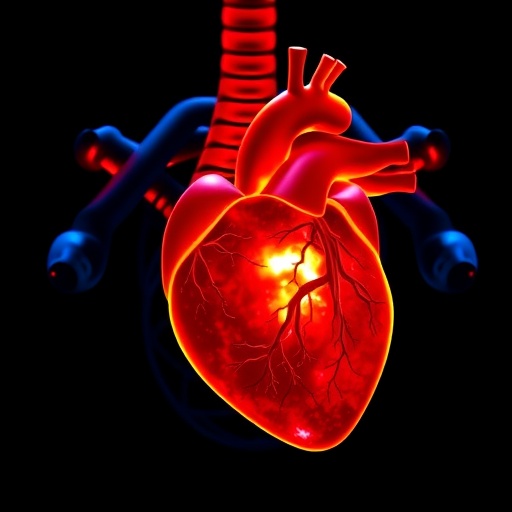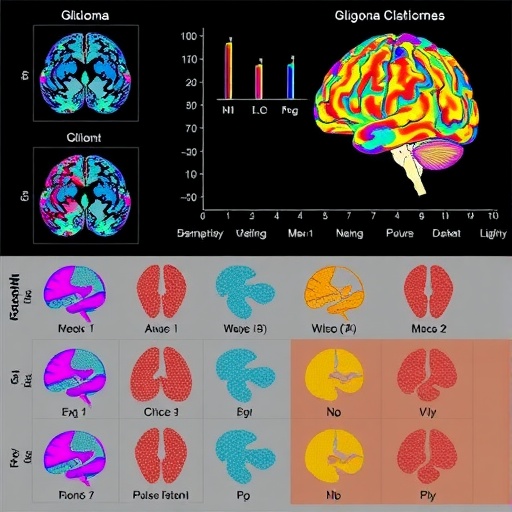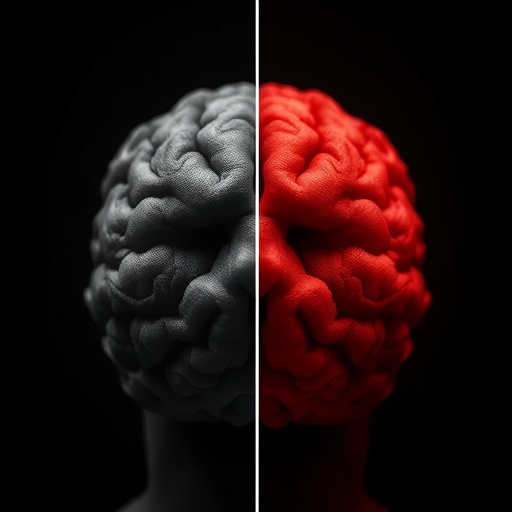In the rapidly evolving field of neonatal care, one of the most formidable challenges remains the early detection and management of brain injury in infants suffering from hypoxic-ischemic encephalopathy (HIE). Recent research spearheaded by Lapointe, Wintermark, Rampakakis, and colleagues introduces groundbreaking insights into the intricate interplay between cardiovascular function and neurological outcomes in these vulnerable patients. The study, published in the Journal of Perinatology in 2025, meticulously explores the association between day-2 cardiac function, assessed via echocardiography and cardiovascular biomarkers, and the extent of brain injury in neonates undergoing therapeutic hypothermia.
Hypoxic-ischemic encephalopathy, a life-threatening condition resulting from inadequate oxygen and blood flow to the infant’s brain during the perinatal period, remains a leading cause of neonatal morbidity and mortality worldwide. Therapeutic hypothermia has emerged as the standard of care, offering neuroprotection and improved survival rates. However, the heterogeneity of outcomes despite hypothermia underscores a critical need for early, reliable biomarkers that could inform prognosis and individualize treatment strategies.
The investigative team focused on evaluating cardiac function at a crucial time point—day two post-birth—utilizing echocardiography and selected cardiovascular biomarkers. Echocardiography, a non-invasive ultrasound-based imaging modality, enables detailed visualization of the neonate’s heart anatomy and function. It provides real-time assessments of parameters such as ventricular contractility, cardiac output, and structural integrity, all of which are vital in understanding how systemic hemodynamics might influence cerebral injury in HIE.
Cardiovascular biomarkers, on the other hand, represent circulating molecules released in response to myocardial stress or injury. By concurrently measuring these biomarkers with echocardiographic data, the researchers sought a multifaceted view of cardiovascular status that might synergistically predict neurological outcomes. Such biomarkers included natriuretic peptides and troponins, traditionally used in adult cardiology but increasingly recognized as relevant in pediatric critical care.
Lapointe et al. enrolled neonates diagnosed with moderate to severe HIE who were undergoing therapeutic hypothermia. Their methodology involved careful cardiac assessment exactly 48 hours after birth—a timing strategically selected to coincide with the completion of the initial hypothermia phase and prior to anticipated neurological imaging. Parallel brain MRI scans were performed to categorize the extent of cerebral injury, allowing correlation of cardiac metrics with neural damage.
One of the striking revelations of this research was the identification of distinct cardiac functional profiles in neonates who later exhibited significant brain injury versus those who did not. The study documented that impaired left ventricular systolic function and elevated levels of cardiac biomarkers were more prevalent in infants with pronounced cerebral lesions. This suggests that cardiac dysfunction, rather than being a mere concomitant phenomenon, might play a mechanistic role in exacerbating neural damage through compromised cerebral perfusion.
Furthermore, the team explored the hemodynamic implications of these cardiac findings. Reduced cardiac output, potentially stemming from myocardial impairment, could lead to insufficient cerebral blood flow at a critical juncture when the brain is highly susceptible to secondary insults. This pathophysiological hypothesis aligns with prior data linking systemic hypotension and poor neurodevelopmental outcomes in HIE, emphasizing the need for precise cardiovascular management in the neonatal intensive care unit.
In addition to structural and functional assessments, the integration of cardiovascular biomarkers enhanced the predictive power of their analytical models. Elevated troponin levels—a marker typically indicative of myocardial necrosis—were significantly associated with worse brain injury scores on MRI. Similarly, increased concentrations of natriuretic peptides, which reflect cardiac stress and volume overload, correlated with adverse neurological outcomes. These findings underscore the utility of a combined echocardiographic and biochemical approach in risk stratification.
Importantly, the study’s multimodal framework offers a promising avenue for personalized neonatal care. Identifying infants at higher risk for brain injury through cardiac assessment may enable early therapeutic interventions targeted at stabilizing hemodynamics, optimizing oxygen delivery, and potentially attenuating secondary brain injury cascades. Moreover, these insights pave the way for prospective clinical trials investigating cardiovascular-directed therapies alongside hypothermia.
The temporal dimension of this study cannot be overstated. Performing cardiac evaluations at day two, just following the cooling period, allows clinicians a critical window to detect subtle cardiovascular derangements and modify treatment plans accordingly. This contrasts with previous research that often focused on later assessments, missing an opportunity for earlier intervention. By synchronizing cardiac and neurological data acquisition, this approach embodies a holistic strategy reflective of the interconnectedness of organ systems in neonatal pathology.
From a technical standpoint, the echocardiographic protocol employed by Lapointe and colleagues demonstrated remarkable reproducibility, a vital criterion for any clinical tool intended for widespread use. Utilizing advanced Doppler techniques and standardized measurement guidelines ensured that the cardiac parameters obtained were both accurate and clinically meaningful, reinforcing the feasibility of translating these findings into routine neonatal care.
Beyond its immediate clinical relevance, this work contributes substantially to our scientific understanding of the pathophysiology underlying HIE. Cerebral injury in neonates is increasingly recognized as a multifactorial process involving not only primary hypoxia but also secondary systemic factors such as inflammation, oxidative stress, and cardiovascular instability. By illuminating the role of myocardial function in this complex milieu, the study enriches the conceptual framework guiding future research.
As neonatal intensive care continues to advance, the integration of cardiology and neurology holds the promise of optimizing outcomes for infants with HIE. The findings of Lapointe et al. advocate for a paradigm shift whereby cardiovascular evaluation becomes an indispensable component of neuroprotection strategies. This multidisciplinary synergy could catalyze the development of novel monitoring technologies and tailored therapeutics.
In summary, the comprehensive investigation into day-2 cardiac function offers a compelling narrative that transcends traditional boundaries of neonatal medicine. The evidence that early cardiac dysfunction and elevated cardiovascular biomarkers correlate tightly with brain injury severity invites clinicians and researchers alike to reconceptualize monitoring and intervention in HIE. This study heralds a future where vigilant cardiovascular surveillance and targeted management refine neurodevelopmental prognostication and care.
As the scientific community digests these findings, the challenge now lies in replicating and expanding the study across diverse populations and clinical environments. Should these associations prove consistent, echocardiography and biomarker profiling could become standard practice in NICUs globally, transforming the landscape of neonatal neurocritical care.
Ultimately, this research embodies the pursuit of precision medicine in its purest form—leveraging detailed physiological insight to mitigate the devastating impact of brain injury in the youngest and most vulnerable patients. The promise this holds for improved survival and quality of life serves as a powerful reminder of why innovation in neonatal research matters profoundly.
Subject of Research: Association between day-2 cardiac function and brain injury in neonates with hypoxic-ischemic encephalopathy undergoing therapeutic hypothermia.
Article Title: Day-2 echocardiography and cardiovascular biomarkers measurements in neonates with hypoxic-ischemic encephalopathy with or without brain injury.
Article References:
Lapointe, A., Wintermark, P., Rampakakis, E. et al. Day-2 echocardiography and cardiovascular biomarkers measurements in neonates with hypoxic-ischemic encephalopathy with or without brain injury. J Perinatol (2025). https://doi.org/10.1038/s41372-025-02419-6
Image Credits: AI Generated
DOI: https://doi.org/10.1038/s41372-025-02419-6
Tags: cardiovascular biomarkers in HIEcardiovascular function and neurological outcomesday-2 cardiac function assessmentearly detection of brain injury in infantsechocardiography in neonatesJournal of Perinatology research findingsneonatal care advancementsneonatal hypoxic-ischemic encephalopathyneonatal morbidity and mortalityneuroprotection in hypoxic-ischemic conditionsprognosis biomarkers for HIEtherapeutic hypothermia for brain injury





